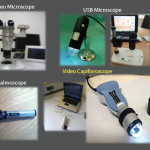Thus, as the pathophysiological process of SSc progresses into fibrosis, capillaroscopic findings most likely reflect the effects of tissue hypoxia: massive capillary destruction, loss of capillaries, areas of avascularity, and bushy capillaries indicating neoangiogenesis (see Figure 10). This advanced stage of SSc characterizes the late capillaroscopic pattern. The classical features of neoangiogenesis also are evident on the skin of SSc patients with advanced disease (see Figure 11).
Although an early capillaroscopic pattern can occur in patients who have suffered from Raynaud’s phenomenon for many years, the term early is used because this pattern tends to occur initially; it also can be observed in patients with shorter disease duration than in those with active or late patterns. However, it must be recognized that capillaroscopic patterns are descriptive and that there is inevitable overlap between patterns. The differences between the pattern in SSc and the normal pattern of healthy subjects or patients with benign primary Raynaud’s phenomenon can be readily observed (see Figure 12).
The development of robust scoring systems to quantify the microvascular change is essential to the performance longitudinal studies. For this reason, a practical system to score these capillaroscopic alterations in patients with SSc has been recently proposed and validated.7,8 Interestingly, in studies on clinical findings over time, about 15%–20% of primary Raynaud’s phenomenon are considered to switch to secondary phenomenon over 12 years in terms of the development of evident clinical symptoms; conversely, when the clinical course is assessed with nailfold capillaroscopy, the transition from primary to secondary Raynaud’s (i.e., associated with SSc) can be detected in only 29 months.9,10
With the use of capillaroscopy for the differential diagnosis of Raynaud’s phenomenon and the follow-up of SSc patients, important studies have suggested links between microvasculature damage and laboratory markers of SSc. One of the first studies on the association between capillaroscopic change and circulating markers demonstrated a correlation between serum levels of the soluble adhesion molecule E-selectin and capillary loss, especially in patients with early disease (within 48 months of diagnosis); this finding suggests that serum E-selectin levels could be a biomarker of disease activity in SSc.11 Serum levels of the tissue kallikrein, a mediator that can act as an angiogenic agent in the microcirculation, also were found to be higher in SSc patients with early and active capillaroscopic patterns compared with those with the late pattern.12 Interestingly, the highest plasma levels of endothelin-1 (ET-1) can be detected in the more advanced stage of the SSc microangiopathy, namely, the late NVC pattern; this pattern is characterized by capillary loss and increased tissue fibrosis. Together, these results may support the involvement of ET-1 in the progression of disease from microvascular to fibrotic SSc damage.13 In this regard, ET-1 could mediate SSc pathogenesis by promoting vascular endothelial cell proliferation, vasoconstriction, smooth muscle hypertrophy, irreversible vascular remodeling in the lungs, and by increasing fibroblast synthesis of type I and type III collagen and fibronectin by a receptor-dependent mechanism.14
Capillaroscopic Analysis to Predict Clinical Complications
Recently, several investigations have evaluated the association of nailfold capillaroscopic patterns with both demographic and clinical features in SSc patients. Data from these studies have shown that SSc microangiopathy correlates with disease subset and disease severity, primarily of peripheral vascular, skin, and lung involvement. In particular, studies indicate that SSc patients with the late NVC pattern have an increased risk of active disease and the occurrence of moderate to severe skin or visceral involvement compared with patients with early and active capillaroscopic patterns.15

